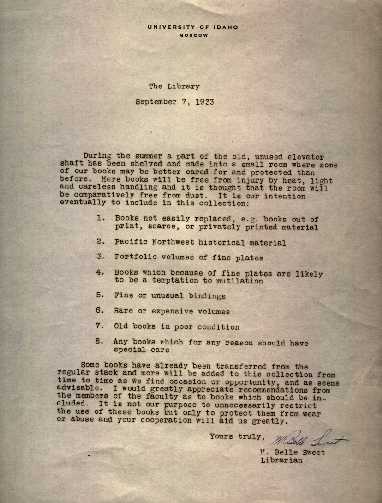Belle Sweet establishes Special Collections
October 2003

Because organizations (like other organisms) grow and change, it is not always possible to mark their precise point of beginning. Appropriately, however, the library's Department of Special Collections and Archives holds just such a document recording its early beginnings. In this memo University of Idaho Librarian M. Belle Sweet announces that an "old, unused elevator shaft" has been converted into a space to store books and materials requiring special care. She does not, in this memo, describe it as a "Special Collection." Nevertheless, items to be included are:
- Books not easily replaced
- Pacific Northwest historical material
- Portfolio volumes of fine plates
- Books which because of fine plates are likely to be a temptation to mutilation
- Fine or unusual bindings
- Rare or expensive volumes
- Old books in poor condition
- Any books which for any reason should have special care
Prior to the designation of this space, a few artifacts and other treasures were displayed in a glass exhibit case beginning about 1923. Among the several items displayed there in 1929 were a 1705 edition of Colley Cibber's The Careless Husband presented to the library by Regent Gertrude Hays upon the dedication of Hays Hall in 1927. This book, since rebound, is still located in Special Collections.
Even so, in 1931, for instance, no library in Idaho was included in the listing of Manuscripts in Libraries of the Pacific Northwest. A manuscript collection, as such, was still a decade or more away.
We can see, over time, the evidence of a gradual realization that some materials require special handling. In her 1939-1940 Biennial Report, Miss Sweet noted that the library was intent on "adding to its collection of material relating to the Pacific Northwest. Much of this material is both rare and long out of print which makes it difficult to obtain. Overland travels, diaries, maps and such material is being sought." Yet there is no mention of how or where such "rare" materials might be stored or made more accessible. The 1941 gift of former Regent Jerome Day's library of Western Americana (the foundation of the library's extensive Day-Northwest Collection) greatly expanded the holdings and made it clear that the elevator shaft was inadequate.
Lee Zimmerman, Miss Sweet's successor, mentioned increased use of the Northwest Collection in his Biennial Report for 1948-1950. This led, in the next biennium, to the creation of "an Archives Room...in the Administration Annex." The preliminary study for the new library (Bookmark 4:2(December 1951)) noted this was a space of about 630 square feet. In the 1952-1954 report, Zimmerman mentions a revision of a "Manual of Policy and Procedures for Special Collections." This was undoubtedly occasioned by a cataloging project:
For years the Library had been accumulating a considerable body of archival materials which was stored in boxes and on library shelves. With the appointment to the staff of Mr. Rodney Waldron, who had previous archival experience, processing this material was commenced in January of 1952. In the 2 1/2-year period, 5,178 pieces of Idahoana were cataloged (directories, documents, manuscripts) and 16,756 pieces of University material (records, pictures, bulletins, circulars) were classified and made accessible to the University community.
When the Library moved from the Administration building to the new library building in October 1957 Special Collections became a semi-separate unit. The closed stacks of Special Collections, like the Map Collection, was "attached to and administered by the Social Sciences Library" under the direction of Charles Webbert, Social Science Librarian.
It was not until 1969 that the unit had grown to the extent of becoming a separate department in the library. Charles Webbert was appointed Special Collections Librarian in charge of a module of space carved out of his former domain in the Social Science Library. In 1974 Special Collections was moved to the ground floor where a wall was built to subdivide the Reserve Room. The subsequent remodeling of library in 1991 expanded and enlarged the space provided for Special Collections to about 10,000 sq. ft. The biggest improvement was to place all of the collection on one level within the library.
In the eighty years since Miss Sweet circularized the campus with her memo, the essential role and function of Special Collections has not changed. Fortunately, the facilities have improved somewhat over the earlier "unused elevator shaft."
Illustration: Memo from Belle Sweet, September 7, 1933. Library Administration Files, 1905-1990. Folder 16. Miscellaneous, 1906-1948. UG 50

 Email Special Collections:
Email Special Collections: Call Special Collections:
Call Special Collections: